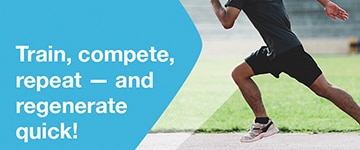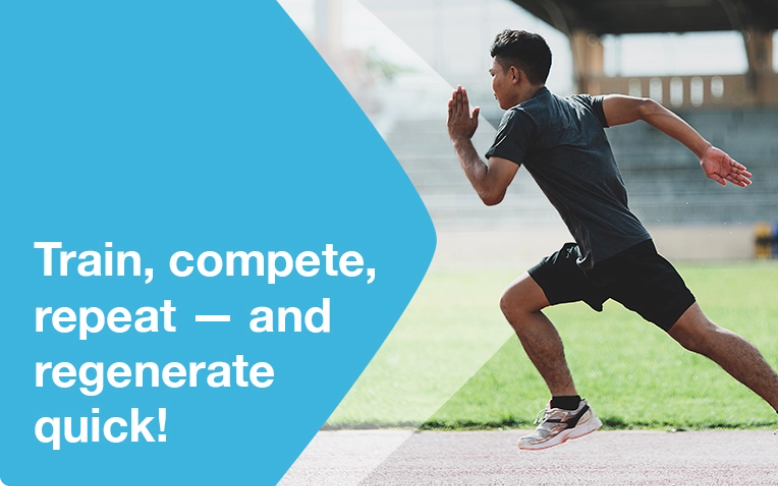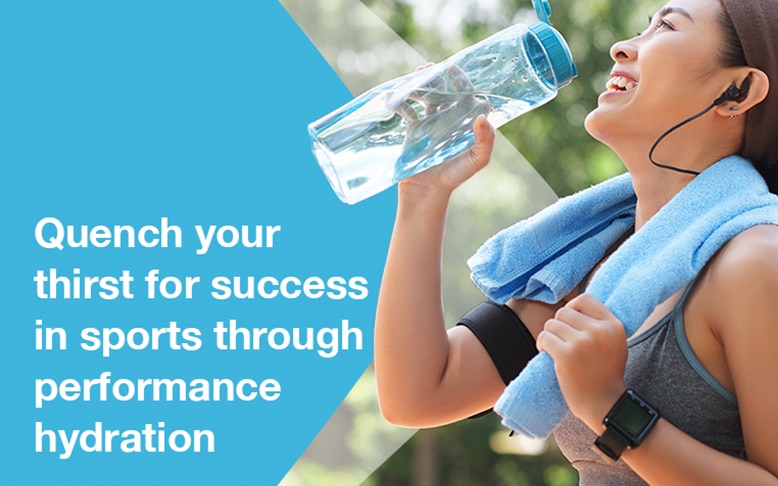Introduction
We all know what exercise is like, and whether or not we enjoy it, to be adapted to the active lifestyle, one must “chew the pain before the gain.” We’ve taken up ways to recover faster from the tiredness and soreness, some with the help of their team of coaches, physical therapists, dietitians, and others. This phase of getting back to fighting form is called recovery, and Recovery Nutrition means ‘planned eating’ that is geared towards these 3 Rs: Refueling, Rebuilding, and Rehydrating. Optimizing recovery nutrition helps an athlete bounce back from a tough training session or an intense competition. From a long view, recovery nutrition also helps facilitate the adaptations from training overtime.
Compared with the pre-event phase, the recovery period is more familiar to a wider audience. This is because the marketed food and supplements for recovery are more widespread than those for pre-event. However, it remains unclear whether simply eating more and drinking exercise supplements can hasten recovery and lead to better performance. Enter the best person to enlighten both athletes and weekend warriors about the benefits of recovery nutrition: the Sports Dietitian.
Isabel Martinez is a sports dietitian who combines research, passion and practice when it comes to sports nutrition. To give you a background of her credentials, Isabel earned her undergraduate degree in Nutrition from the University of the Philippines Diliman, a Master in Science Degree in Kinesiology from the University of Illinois at Urbana-Champaign, and a Diploma in Sports Nutrition from the International Olympic Committee; she has first-hand experience in conducting sports nutrition research. Her time with the Nutrition and Exercise Performance Research Group has led to several scientific publications, book chapters and reviews mostly focusing on topics related to recovery nutrition.
She previously discussed the benefits of pre-event nutrition, and she’s back with us to tell us more about recovery nutrition.
Basics of Recovery Nutrition
NM: Hello, Isabel. It’s nice to talk to you again. Before diving into recovery nutrition, can you first enlighten us about recovery?
Isabel: Recovery, in the context of sports, is the process of restoring the capacity to perform of the athlete. There are two types of recovery: acute and long-term. Acute recovery or rapid recovery covers 1-6 hours post exercise. Long-term recovery, on the other hand, spans days to even months and covers day-to-day recovery from training sessions which facilitate long-term adaptations of the body, such as improvements in the muscle or the cardiovascular system. These improvements subsequently lead to enhanced performance.
Under recovery is recovery nutrition, wherein you provide food and fluid to help restore the capacity to perform. Other areas are physical techniques, psychological factors and sleep, to name a few.

NM: What are the basics of recovery nutrition?
Isabel: Recovery is holistic and involves various physiological processes. The recovery duration depends on many factors, including exercise intensity and duration.
Acute or rapid recovery nutrition is the process of immediately providing essential nutrition right after the competition for athletes to be able to withstand the demand of sports with multi-event formats.
One example is soccer festivals, wherein multiple games occur within a day separated by only a few hours. Another example are regattas which competitions span over days and athletes compete in multiple heats in a day and across days. Athletes who also engage in prolonged endurance events may benefit from immediate replenishment of nutrients and fluids.
For other sports that consist of a single, short or light-moderate intensity event or alternatively, after a light training day, provision of food and fluids may not be as urgent, especially if the athlete will eventually consume a meal in the following hours.
The 3 Rs of Recovery
NM: Can you tell us about the 3 Rs of Recovery?
| 3 R's | Refuel | Rehydrate | Rebuild |
|---|---|---|---|
| Definition | Restoration of muscle and liver glycogen | Replacement of lost fluids and electrolytes | Repair and remodeling of protein - includes muscle, connective tissues, etc. |
| Nutrient Need | 1 - 1.2 g/kg BW/house carbohydrate within the first 4 hours post-exercise | 1.5x of fluids lost during the session | 0.25 - 0.30g/kg BW per meal |
| Consideration | Form of carbohydrate (i.e. solid food or fluid), spread (i.e bolus or in small doses), athlete's overall energy availability status | Provision of fluids with electrolytes or including solid food to provide electrolytes, highly individualized depending on external factors and degree of fluid loss, number of session/events in a day | High quality protein whether isolated or whole food, note spread of protein across meals throughout the day |
Isabel: Refuel pertains to post-exercise restoration of muscle and liver glycogen. Between the two, muscle glycogen restoration takes longer, at least 24 hours, as liver glycogen is prioritized. The degree of glycogen repletion depends on many factors, including the intensity of exertion, if the athlete is completely resting during recovery, and gender (menstrual cycle and hormones affect recovery).
In terms of nutrition, the amount of carbohydrate intake should be observed, with the recommendation being 1-1.2 grams per kilogram of body weight per hour post-exercise. Moreover, the type of carbohydrate should be noted. Generally, choose carbohydrate-rich and nutrient-dense food and fluids that meet the energy needs and goals of an athlete. Timing is also important, with studies showing carbohydrate intake in the immediate hours to be beneficial to muscle glycogen repletion. The form and spread of the carbohydrate should be noted as well, i.e., whether the athlete can intake a certain amount (e.g., 800 mL) at once or spread out (e.g., 200 mL in 4 separate doses). The athlete’s status of energy availability (i.e., the athlete consuming adequate calories to provide optimal carbohydrate intake) should likewise be noted. The athlete may be consuming carbohydrates, but the amount may not be enough or the overall caloric intake is inadequate, then the ingested carbohydrates may be used for other bodily needs and not actually replenish the muscle and liver glycogen stores.
Rehydrate means replacing lost fluids and electrolytes. Athletes should start a session or a competition in a euhydrated state, or a state of having not too little or too much hydration. One way to measure hydration is by body weight (pre-competition weight vs post-competition weight). An athlete should consume 1.5 times of the fluid lost 5 hours post-exercise, which roughly translates to 600 mL per hour for every 2 kg of body weight lost. Of course, this recommendation for rehydration may have to be adjusted based on other factors, such as temperature and humidity, tolerance or whether the athlete has limited time before a succeeding event.
Rebuild pertains to repairing damaged protein. Protein has been widely noted as the main ‘recovery’ ingredient; however, it should be pointed out that recovery involves long-term effects. These long term effects facilitate the desired changes of the body in response to exercise.
The recommended protein dose per meal is 0.25-0.4 grams of high-quality protein per kilogram of body weight. In terms of recovery nutrition, 20-25 grams of high-quality protein is the absolute dose that is recommended; however, relative to body weight recommendations are always better. As for daily protein targets, I would like to point out that endurance athletes also have increased protein needs, much like or even more than resistance or power athletes, who are more commonly thought to need the most protein. This is because endurance athletes do not only need to eat protein to repair and remodel but also offset all the amino acids oxidized during exercise bout. Athletes should also ensure adequate protein intake in each meal throughout the day4.
For a protein to be considered ‘high-quality’, it needs to have the complete array of essential amino acids. These proteins are usually animal-based. Studies have compared animal to plant-based proteins (e.g., whey vs. casein. vs. soy isolates) and found that while soy has decent amounts of essential amino acids, the difference comes down to the way the body digests and absorbs these proteins. Dairy protein, like whey, is rapidly digested and absorbed, and this is why it has received much attention in the protein world.
There are two more Rs that I’d like to add, as they are new areas of research.
Regulation is concerned with gut integrity or gut patency. Current research is looking into the effects of exercise on the gut: How much does the gut get damaged by exercise? With the exercise-induced gut damage, what is its effect on the post-exercise diet in terms of capacity to digest and absorb nutrients? Is the gut microbiome affected by exercise and how does this affect the body in turn? These are the questions being raised in this new area. It’s not uncommon for athletes to complain about gastrointestinal symptoms (i.e. bloating, belching, stomach cramps) hampering their performance, especially for those competing in hot conditions or engaging in high-intensity or longer-duration sports. These symptoms are outcomes of the body’s normal response to exercise. So far, the most promising strategies in managing this include identifying the individual tolerance of an athlete when it comes to carbohydrate and protein consumption before and during exercise; training the gut to handle a high volume of carbohydrates; and minimizing foods that may cause gut distress. Nutrients and active ingredients such as glutamine, arginine, L-citrulline, nitrate and curcumin, have all been proposed to mitigate gut damage during and after exercise. However, evidence that shows these nutrients and active ingredients having substantial effects is lacking.
Restoration refers to the restoration of immune competency post-exercise. Exercise usually causes a depression in immune function, thus it is proposed that recovery nutrition should also cover boosting immunity. Adequate consumption of protein, carbohydrate, as well as nutrient-dense foods that provide immune-boosting vitamins and minerals is the starting point of this process. Moreover, adequate vitamin A, D, E, B6 and B12, and minerals, like iron and zinc, in the diet are vital in maintaining immune function. So far, the most promising are probiotics, vitamin D3 and quercetin, which are backed by emerging evidence in terms of efficacy9.

Regulation and Restoration raise the concern that whatever food is provided during recovery should also aim to reduce gut burden and promote immune function. The research is promising in these areas, and majority of researchers are looking at dairy-based recovery drinks, as these contain carbohydrate, protein, fluids and some of the beneficial micronutrients for recovery. These being said, the athlete’s preference, along with availability, convenience, and other factors should still be considered. While dairy-based recovery drinks are promising on paper, inconvenience in procuring them or the athlete not liking the food item might take chocolate milk off the table. Meeting the athlete halfway is crucial when it comes to recovery nutrition.
NM: When an athlete or sports enthusiast engages in training or an event, does it always lead to muscle damage?
Isabel: Skeletal muscle is very plastic – meaning it can change and adapt and is very sensitive to stimulus. Muscle mass is maintained by balancing two opposing processes: muscle protein synthesis (MPS) and breakdown (MPB). If one wants to gain muscle, then synthesis must be greater than breakdown or one should be in a positive long-term balance. Consumption of food leads to MPS being higher than MPB. Eventually, if MPS is sustained, muscle building occurs. What about the effect of exercise on muscle protein synthesis? Does exercise only lead to breakdown? Actually, exercise results to both MPS and MPB, but the overall muscle protein balance (negative or positive) depends on whether an individual is fasted or fed10.
The notion that exercise leads to damage is closely associated with breakdown only, and this is always viewed in a bad light. But this is a very important component of muscle remodeling, because breakdown is needed for the adaptations secondary to training. These adaptations include muscle changes in terms of capacity to generate more power or more efficiently used fuel stores.
Exercise also leads to an increase in MPS. In fact, the balance between MPS and MPB is improved with exercise but still remains in the negative state (higher breakdown than synthesis). A synergistic stimulation of MPS is evident when you consume protein following exercise. This is why we need to provide food - in order to tip the balance to a positive state. While it is true that amino acids are the building blocks of muscles, they also serve as signaling molecules that encourage anabolism, especially essential amino acids and in particular, leucine.
I cited both the benefits of exercise and nutrition in terms of rebuilding because these work synergistically to optimize the benefits from exercise and improving performance.
Start of Recovery Nutrition
NM: How soon should Recovery Nutrition start?
Isabel: As mentioned, there are situations in which athletes need to refuel or rehydrate as quickly as possible after an event. Also, if an athlete has high nutrition requirements due to a long race or a really intense training session, then providing a quick recovery snack right after would be an opportunity to contribute towards that goal. One thing to keep in mind is that following a strenuous session, appetite can be affected and an athlete might not feel like eating right away. Liquid nutrition might be a good option for this. It’s really all about feasibility when it comes to timing!
Markers of Recovery Nutrition
NM: During the recovery phase and in observing recovery nutrition, are there markers (blood sugar, protein levels, etc.) that should be closely observed?
Isabel: Hydration status is definitely one thing that’s closely monitored. In the field, markers and indicators of hydration status are the color, volume and osmolality of urine; body weight changes (<1 – 2%); and pulse rate and systolic blood pressure.
Possible Drawbacks of Incorrect Recovery Nutrition
NM: What are possible drawbacks of incorrect or insufficient recovery nutrition?
Isabel: For incorrect rapid recovery, possible drawbacks include suboptimal performance in subsequent games. On the other hand, insufficient long-term recovery may hinder benefits from training in terms of adaptation, which is counterproductive to the main goal of training.
Recovery Nutrition Based on Age
NM: Does recovery nutrition differ between young athletes and old athletes?
Isabel: Same with pre-event nutrition, there are no recommendations based on RDA for young athletes.
However, for older adult athletes, research is very active. Aging and muscle loss are current research hotspots, and it has been shown that in the 4th decade of life, age-related muscle loss begins. What does this mean for master athletes, or athletes over 40 years old? This means consuming more to achieve the same effect. Let’s use 20-25 grams of protein as an example: in this age bracket, up to 40 grams of protein has been shown to be the more effective dose to stimulate the muscle. There’s also emphasis on the spread of protein throughout the day, making sure that each meal and snack contains protein and such is not only concentrated in certain meals (e.g., lunch and dinner).
Recovery Nutrition Based on Different Sports
NM: Do different sports require different recovery nutrition meals?
Isabel: Going back to the factors that affect the depletion of fuel stores, it would depend on the duration and intensity of the exertion. Endurance sports consume more fuel because they are longer, and the diversity of fuel is different as well. As a result, the recovery time may be longer and attention to nutrition should be given on a longer term (i.e., past immediate 1-6 hours post-exercise).
However, between different sports, the primary aim of recovery nutrition would still be the same: repair, rehydrate, rebuild. But there may be special considerations based on the peculiarities of each sport, such as competition format, duration of an event, and location of competition, among others.
Cost of Recovery Nutrition
NM: Now that we have a better idea of recovery nutrition, will it be expensive to put together a meal plan for recovery?
Isabel: Same with pre-event nutrition, the recovery meal should consist of foods the athlete is already used to, with added guidance from the nutritionist-dietitian. Acute recovery guidelines are similar to those for pre-event nutrition, i.e., high-carbohydrate, low-fiber and low-fat, plus fluids and electrolytes. I highly encourage maximizing whatever is available and accessible, as to not incur added cost.
A recommendation for immediate replenishment of carbohydrate and fluid stores are sports drinks. There are also energy bars and other sports food, but cost and convenience have to be weighed.
For day-to-day recovery or long-term recovery, this is where we highlight meeting the protein goal of the athlete. Think high-quality protein – lean cuts of meat and poultry, seafood, egg and dairy. You also have your plant-based protein and dairy alternatives; just take note of the limitations of these in terms of their amino acid profile. Sports supplements have a role in long-term recovery, so this is where protein powders come in, but these should only supplement the diet and not be the only or main source.
Let’s talk a bit more about plant-based proteins versus animal-based proteins. Achieving the recommended 20-25 grams absolute dose of protein varies between animal-based and plant-based sources. Animal-based proteins are more protein-dense compared to plant-based proteins. This means, you’d have to eat more plant-based protein in terms of amount to meet the recommended dose compared to animal-based protein (e.g., 2-3 eggs vs 100 g soy milk). Some plant proteins are also high in fiber and therefore more filling, making it difficult for the athlete to consume, especially post-exercise because appetite is suppressed. However, this is not to dissuade vegans from consuming plant-based proteins or participating in athletics, only that there should be adjustments in timing and types of plant-based protein consumed together.
Sample Meal Plan
Swim Meet
- Competition is whole day with multiple races in the morning and afternoon, separated by as little as 20 minutes
- 2-hour break between morning and afternoon events
| Timing | Sample Rapid Recovery Nutrition* |
|---|---|
Between events Make available simple carbohydrate snacks and fluids to the athletes and let them "graze" | Any of the following:
|
During 2 hour break between morning and afternoon
RP
Post-competition recovery snack and meal | ¾ - 1 cup noodles, rice or wheat ¼ - 1/3 cup shredded chicken, boiled, 1 - 1 ½ cup sports drink
OR
¾ - 1 cup rice 1 piece chicken thigh, grilled, skin removed 1 - 1 ½ cup sports drink
Fruit smoothie 1 pc banana |
| Snack to be consumed as soon as possible followed by a full meal (see examples below) | 2 tbsp sugar ice water OR 1 cup flavored milk (e.g. chocolate milk) 1 piece banana |
*Recommendations based on a 60kg athlete
Basketball Game
- Competition is mid-afternoon
- Scheduled after-game team dinner close to competition venue
| Timing | Sample Rapid Recovery Nutrition* |
|---|---|
Post-game meal Provide fluids and electrolytes and a full meal with carbohydrate, protein and fat | 1 cup mashed potato ½ piece grilled corn 1 palm-sized piece steak ⅓ cup steamed vegetables 1 cup fruit juice water
OR
1 cup pasta with sauce 1 palm-sized piece chicken 1 piece garlic bread ½ cup mixed salad 1 cup sports drink water |
*Recommendations based on a 60kg athlete
NM: Thank you, Isabel Martinez, for expanding our idea of recovery and recovery nutrition. We’ve learned that recovery isn’t a simple process, and there’s more to consuming food in order to recover.
Better information about recovery and recovery nutrition hopes to inspire casual sports enthusiasts into living more athletic lifestyles, and bring athletes closer to becoming champions. However, it bears repeating that nutrition isn’t the only adjustable factor in having an active lifestyle. Listening to your body and seeking guidance from a professional dietitian are crucial in any level of active engagement, whether the goal is towards competition or a healthier lifestyle.
Sports hones important life skills: discipline, self-confidence and determination. Know more about MILO and sports by visiting this link.


 Isabel G. Martinez , RND, MSc
Isabel G. Martinez , RND, MSc













No comments here yet.